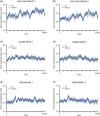Idiosyncratic pupil regulation in autistic children
- PMID: 39385709
- PMCID: PMC11638892
- DOI: 10.1002/aur.3234
Idiosyncratic pupil regulation in autistic children
Abstract
Recent neuroimaging and eye-tracking studies have suggested that children with autism exhibit more variable and idiosyncratic brain responses and eye movements than typically developing (TD) children. Here, we extended this research to pupillometry recordings. We successfully acquired pupillometry recordings from 111 children (74 with autism), 4.5-years-old on average, who viewed three 90 s movies, twice. We extracted their pupillary time-course for each movie, capturing their stimulus evoked pupillary responses. We then computed the correlation between the time-course of each child and those of all others in their group as well as between each autistic child and all children in the TD group. This yielded an average inter-subject correlation value per child, representing how similar their pupillary responses were to all others in their group or the comparison group. Children with autism exhibited significantly weaker inter-subject correlations than TD children in all comparisons. These differences were independent of previously reported differences in gaze inter-subject correlations and were largest in responses to a naturalistic movie containing footage of a social interaction between two TD children. The results demonstrate the utility of measuring the idiosyncrasy of pupil regulation, which can be performed with passive viewing of movies even by young children with co-occurring intellectual disability. These findings reveal that a considerable number of children with autism have significantly less stable, idiosyncratic pupil regulation than TD children, indicative of more variable, weakly regulated, underlying neural activity.
Keywords: Autism; idiosyncrasy; inter‐subject; naturalistic; pupil; pupillometry.
© 2024 The Author(s). Autism Research published by International Society for Autism Research and Wiley Periodicals LLC.
Conflict of interest statement
Behrmann is a founder of Precision Neuroscopics, a company developing medical technologies with a focus on equity and inclusion in healthcare. All other authors declare no competing financial interests.
Figures





Update of
-
Idiosyncratic pupil regulation in autistic children.bioRxiv [Preprint]. 2024 Jan 12:2024.01.10.575072. doi: 10.1101/2024.01.10.575072. bioRxiv. 2024. Update in: Autism Res. 2024 Dec;17(12):2503-2513. doi: 10.1002/aur.3234. PMID: 38260528 Free PMC article. Updated. Preprint.
References
-
- Bast, N. , Boxhoorn, S. , Supér, H. , Helfer, B. , Polzer, L. , Klein, C. , Cholemkery, H. , & Freitag, C. M. (2023). Atypical arousal regulation in children with autism but not with attention‐deficit/hyperactivity disorder as indicated by pupillometric measures of locus coeruleus activity. Biological Psychiatry: Cognitive Neuroscience and Neuroimaging, 8(1), 11–20. 10.1016/J.BPSC.2021.04.010 - DOI - PubMed
-
- Bayley, N. (2006). Bayley scales of infant and toddler development (3rd ed.). Harcourt Assessment. 10.1177/0734282906297199 - DOI
Publication types
MeSH terms
Grants and funding
- The Research to Prevent Blindness Inc
- T32GM008208/GM/NIGMS NIH HHS/United States
- Simons Foundation Autism Research Initiative
- T32 GM008208/GM/NIGMS NIH HHS/United States
- Israeli Ministry of Science and Technology
- Azrieli Foundation
- P30 EY008098/EY/NEI NIH HHS/United States
- T32 GM081760/GM/NIGMS NIH HHS/United States
- T32GM081760/GM/NIGMS NIH HHS/United States
- EY08098/EY/NEI NIH HHS/United States
- 1150/20/Israeli Science Foundation
- P30CORE/EY/NEI NIH HHS/United States
- Eye and Ear Foundation of Pittsburgh
- P30 EY008098/EY/NEI NIH HHS/United States
LinkOut - more resources
Full Text Sources

